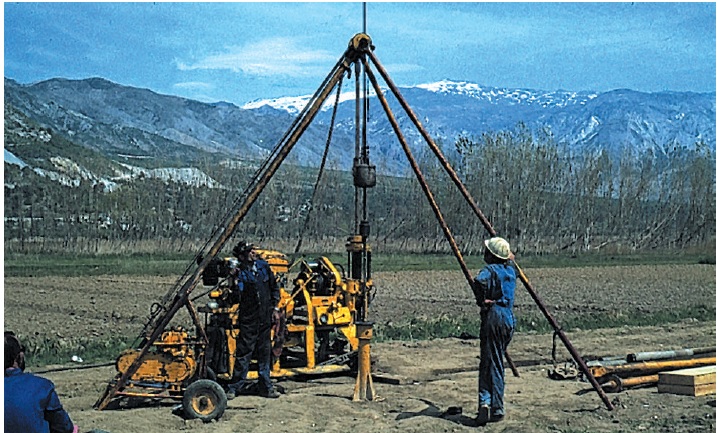Standard penetration test (SPT)

Standard penetration test (SPT)
Standard penetration test – SPT is a dynamic penetration test carried out inside boreholes. It gives a penetration resistance value N that can be correlated with geotechnical parameters such as relative density, friction angle, and settlements in granular soils. The penetration resistance (N) is the number of blows required to drive the split spoon sampler for the last 30 cm of penetration. A disturbed sample is also obtained from this test for carrying out identification tests in the laboratory.

The SPT can be done in practically all types of soil, even in very disturbed rock, although it is recommended for use in granular soils; the difficulty in obtaining undisturbed samples in these types of soils makes SPT even more relevant. Standard penetration test SPT is usually carried out as the borehole progresses at a frequency of about one every 2 to 5 m, or more, depending on the characteristics of the ground.
The procedure followed consists of carefully cleaning the bottom of the borehole of debris to the depth required for the test, removing the drilling rod and installing in its place a standard-sized sampler. This has three components: the drill shoe, the split spoon sampler and the coupling head attached to the rod.
It should be driven 60 cm into the ground and the number of blows to drive in each 15 cm section should be counted. Blows are produced by a 63.5 kg hammer falling from a height of 76 cm onto an anvil plate (Figure 1).

The readings from the first and last 15 cm section should not be considered, in the first case because of soil disturbance and wall collapse, and in the second because of possible over-compaction. The penetration resistance N is the number of blows required to drive in the split spoon for the two middle 15 cm sections (30 cm total) of penetration. If the advance or penetration of the sampler is very slow, or rebounds due to the strength of the ground, and more than 100 blows are needed for the sampler to advance 15 cm, the test is discontinued.
Standard penetration test – SPT results may be affected by the following factors:
— Quality of the borehole: cleanliness and stability of the borehole wall.
— Rod length and borehole diameter may condition the weight driven in and generate friction with the borehole walls.
— Hammer device: this can be manual or automatic, with significantly different results for each method; automatic devices awre preferable as they guarantee the same impact force every time.
When SPT is carried out below the water table the following correction is applied to low permeability soils (silts and fine sands):
N = 15 + [(N’ – 15)/21]
valid for N’ > 15, where N is the corrected value and N’ the value measured.
The extensive use of SPT has led to the establishing of a series of correlations with different geotechnical parameters:
— Depth correction using the ratio between relative density and N value
— Friction angle in granular soils (φ) applicable below a depth of 2 m
— Compactness in granular soils
Relationship between SPT values, angle of friction and relative density in coarse grain soils
| N (SPT) | Relative density | % | φ (º) |
| 0–4 | Very loose | 0–15 | <28 |
| 4–10 | Loose | 16–35 | 28–30 |
| 10–30 | Moderately dense | 36–65 | 30–36 |
| 30–50 | Dense | 66–85 | 36–41 |
| 50 | Very dense | 86–100 | 41 |
Limitations
The value of N must always be considered as a rough approximation of soil compactness or consistency in view of the various influencing factors. Even under controlled laboratory testing conditions, a single value for N can represent a spread of +-15% in DR (Marcuson and Bieganousky, 1977b).
